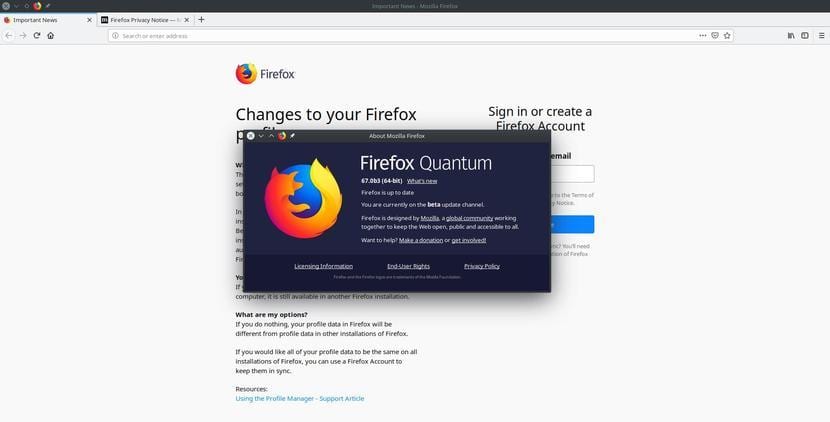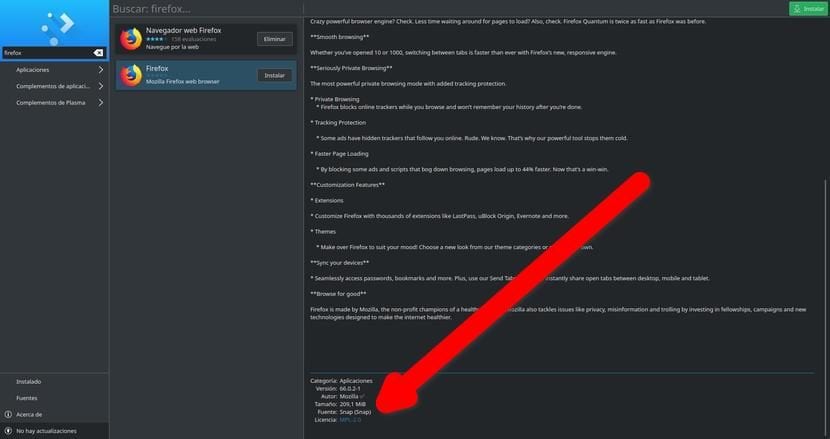
I must admit that I am the first surprised to learn that it is a question that many users have. The surprise is reduced a bit if I take into account that there are several ways to have Firefox on Linux, existing, at least, APT, Snap versions and the binaries. With this in mind, I have decided to write an article that any user who is clear about it has to stop reading from now on, since we are going to explain how to update firefox on Linux.
Next I will explain how to do it in the 3 ways that occur to me depending on what version we have installed on our Linux PC. From 2015-2016 we have new types of packagesNot to mention that there is the possibility of updating Firefox ahead of time with the binaries or we can use the same to update a beta version. You have everything you need to know after the cut.
How to update Firefox in its APT version
The vast majority of users will have the APT version of Firefox installed. What is the APT version? This is the version that is installed by default in Ubuntu and many other operating systems. This version comes with the main software and some dependencies that will depend on the operating system that we are using. In addition, as not all the software comes in the same package, its image will vary depending on the graphical environment that we are using. RIGHT NOW is the version I use and I recommend that you use all those who read me.
Updating it is so simple that it has no loss. But one thing must be taken into account, and this could be the reason why some users have doubts: the APT version is not available at the same time that either Mozilla or we publish that there is a new version. If we have the APT version installed we will have to wait a while for the new version to be added in the official repositories. Firefox 66 hit the APT repositories two days after its release and here's what to watch out for.
To update it we will do the following:
- We open our software center, which will be different depending on the operating system we use.
- We go to the updates section.
- If there is a new version, we choose "Update" or "Update all".
- We wait for the installation to finish and we will have it. No need to reboot.
This will be in the event that we are in a rush to install it. If we don't do it manually, sooner or later we a notification that we have pending updates will appear, at which time we have to accept to install the new version of Firefox and all available updates.

And in the Snap version?
This question is already a bit more complicated RIGHT NOW, and I'm rewriting this in uppercase. And is that right now Firefox in its Snap version does not offer updates as it should, that is, from the "Help / About Firefox" options, from where we should see that there is a new version and accept it to update. A message should also appear warning that there is a new version as soon as Firefox starts, but this is not the case (right now it offers us a link from where to get the binaries). I think it's important to make it clear that this will be the way to do it if you read this post within a time when Mozilla decides to enable this option.
Before continuing: What is the Snap version? Is about the version that is available in the Snappy Store and is different from the APT in:
- In theory, it will update instantly thanks to push updates. This is not the case in April 2019.
- It is all software in one package. This means that, at least at the time of writing this article, its integration is not as perfect as the APT because it is more "closed". He is also responsible for the next point.
- It has a UI that may not look good on your operating system. Containing both core software and dependencies in one package also means that that package has a predefined image. As with many other programs, the Snap version of Firefox may not look as good as APT on your operating system. The reason is that it has a generic design, so it can be out of tune (and out of tune) in many graphical environments.
If we want to know how to update Firefox in its Snap version today (April 2019), say that we have to do it as in its APT version, following the same steps. If the update does not appear directly, we can also search for "Firefox" in our software center, where two versions will appear, the APT and the Snap, we enter the Snap and see if it says "Update". If so, we update from there. To know what version it is we have to look at the details of Firefox, which are below the information of the program.

Another option is to go back to ewrite «sudo snap install firefox«(Without the quotes), at which point it will tell us that we already have it installed and will suggest us to use the correct command, which is "Sudo snap refresh firefox", also without the quotes.
Needless to say, they have finally updated the Firefox Snap package in the Snappy Store. It was stuck in v65.xx for a long time when those of us who had the APT version were already enjoying all the benefits of Firefox 66. Without a doubt, all this will improve in the future.
If you are wondering how to update Firefox in its Flatpak version, at the time of writing these lines does not exist. At the moment it exists, if it is the case, the update system will be the same as in its Snap version, that is, via push or from the software center. The most common will be push updates.
Are you wondering how to do it on Windows or macOS?
I understand that many of you think that this part is unnecessary. Ubunlog, but we are here to help and maybe there are Windows and macOS users who don't know how to update Firefox. In Windows and macOS, a system similar to how Snap and Flatpak packages should do it is used, that is, a notification should appear warning that there is a new version. If we see such a notification, we will:
- We click on the three lines to enter the options.
- We click on Help / About Firefox.
- There we will see if we have the latest version or if there is an update. By default, updates are downloaded automatically, so if there is one we will see a text indicating that it is downloading.
- Once the new version is downloaded, we restart Firefox for the changes to take effect.
How to update Firefox Beta from its binaries
And whoever says "Beta" also says an official version on the day of its launch. The only thing is that I honestly do not recommend it; I don't see a real need to "play" with the binaries if we are going to have an APT version available soon. That is why I mention that it is better if we do it in a beta. Upgrading from binaries is easy and you just have to follow these steps:
- We click on this link to download the binaries. You can also do it from here.
- Unzip the downloaded file. There are ways to do it from the terminal, but it is best to use the decompressor that our operating system has. It will create a folder called «firefox».
- If we have it open, we close Firefox.
- The folder that we have unzipped in step 2, without touching it, we copy it to the path usr / lib.
- When you consult us, we overwrite the one that was there. If we need root permission, we can do it with "sudo nautilus" in case we use Ubuntu.
- We restart Firefox so that it starts with the new binaries. The good thing is that the configuration files are stored in our personal_folder / .mozilla, so we will not lose any settings whatever the installation / update method we have used.
If we update a version from the binaries, the theory says that when there is a new version it will read the information from them and offer it to us as if we had updated from the official repositories, but one thing is theory and the other is practice. . I comment on the theory, but I do not like to state emphatically something that might not be fulfilled.
UPDATED: binaries, at least as of Firefox 67, are updated from the same browser as in Windows and macOS.
How to install Firefox Beta
To cover all the possibilities, now that we talk about the beta version, we can update it the same as the APT version, but for this we will have to add the beta repositories from Firefox. Keep in mind that if we do, we will always be updating from beta to beta, but for those who are interested, we will do it with these commands:
sudo add-apt-repository ppa:mozillateam/firefox-next sudo apt-get update
Once the previous commands have been written, we can treat the beta the same as the APT version that we had installed by default. This I would only recommend for developers.
I hope I have solved all the doubts that users had about how to update Firefox. Those of you who did not have it, understand that not all users know how to do everything, especially now that the Snap version exists and that blogs such as where a server writes, we publish the new updates just at the moment in which Mozilla announces them.
Has this article helped you?
